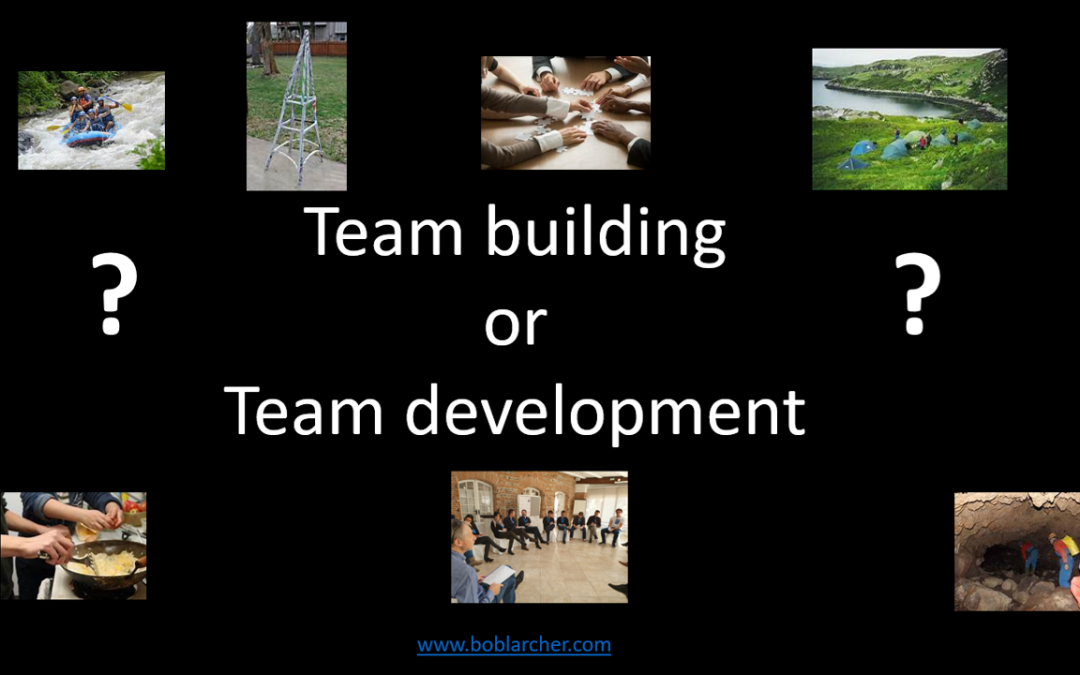I am often asked, “do you have a team building activity you could recommend” and my answer is always, “it depends on what you want to with it”; to which the reply is usually a bit of a blank look and “well, teambuilding”.
So, what is the purpose of a team building activity?
In my opinion it is, “an activity that will both replicate, in some way, one or more of the issues hindering the team’s development, and help the team to find solutions to the issue(s)”
Team building is a fairly vague term and is often reduced to a team doing something “fun” together without any real investigation into the problems and issues the team is facing.
Personally, I prefer to talk about “team development” and how team building activities can contribute to the team’s development.
Since facilitating my first team building in 1987, I have lost count of the number of team building workshops, seminars and events that I have been involved in.
Teams have built things together (towers, bridges, rafts ………), they have gone on journeys together (through caves, over mountains, down rivers, ……), they have lived together (bivouacs, camping, mountain huts, ………), they have solved problems together (enigmas, quizzes, puzzles, …….), they have compared personality profiles together (Insights, Belbin, Social Styles, ……), they have performed together (songs, theatre, shows, ….) and they have done a whole host of other things together.
All the activities I have used were always used for a specific reason; the activity would always have a “learning” objective that in some way would contribute to the team development process.
If I put my hand on my heart, I can’t say that every activity delved deeply into the team’s key issues but, they were, even in a small way, contributing.
Much of my early work in both teambuilding and leadership was in the outdoors and early on I was inspired by the Dainty and Lucas “Outdoor Development Outcome Matrix“.
Their approach looked at activities in two dimensions
In this framework activities are classified along a continuum ranging from “loosely defined” to “tightly defined”. A loosely defined exercise being one with limited rules and imposed external constraints (except in terms of safety), such as timeframes, budgets etc. A tightly defined exercise is one which has a high degree of imposed rules and constraints.
The review processes are also classified along a continuum ranging from “low intensity” to “high intensity”. Low intensity reviews tend to be more general, concentrating on the team’s performance with the aim of developing general rules or guidelines for the team as a whole. High intensity reviews concentrate more on the impact of individual behaviours with individual feedback, concentrating on how individual behaviours effect team performance.
The combination of these two dimensions results in four types of outcomes
Loosely defined activities with a low intensity review; typically used as “icebreakers” or “energisers”, these generally fairly short activities concentrate on simply “doing something together” and “having fun while doing so”.
Loosely defined activities with a high intensity review; typically used to explore group dynamics and how individual behaviour effects the overall team performance. The review would probably delve into areas such as, who takes initiatives, who dominates, who listens, who’s ideas are retained, etc.
Tightly defined activities with a low intensity review; typically used to explore how the team approaches “getting the job done”, areas such as objectives setting, work sharing, time management, coordination, etc.
Tightly defined activities with a high intensity review; typically used to integrate the key issues the team is facing and concentrating on both group dynamics and producing results. This type of activity is often used toward the end of a seminar to allow the team to experiment the application of what they have identified as their “improvement areas”.
Many activities can be easily adapted in terms of being loosely or tightly defined.
Take a typical “raft building” activity for example
Give the team limited time and “budget” to design, “buy” (and/or locate) materials to build a raft capable of getting the team between two fixed points, carrying a minimum number of people, with no one getting wet above the ankles, in less than……. etc., and you have a fairly tightly defined activity.
Of course, take away the imposed rules and simply brief the team that they have to cross the river and that there are some materials available that may be useful, and you have a more loosely defined exercise.
The intensity of the review is down to the facilitator and what she/he wants to explore.
All of this, of course, means that a teambuilding activity doesn’t (or shouldn’t) happen in “splendid isolation”, it is part of a process that includes some kind of team audit or diagnosis prior to any programme design or choice of activities.
Don’t get me wrong, I have nothing against team “away days” where the team will do a variety of different activities together, which, even without reviews or debriefs, will, usually be beneficial to creating a positive team atmosphere. I say “usually”, because sometimes hidden conflicts between team members can be, unintentionally, exacerbated.
An effective team development process clearly has a before, during and after and requires time.
Taking time before to understand the team’s issues and problems. Devoting the time necessary during the event to allow a real exploration of the issues and find practical solutions. Allocating time after the event to ensure the application of the solutions.
And, yes, the process is often “cyclic”, with the after becoming the new before.
I’ve been involved in the design and facilitation of team development for almost 40 years now, if you would like to talk about team development be it as a team leader or someone facilitating team development; do not hesitate to contact me.

I help people to develop their interpersonal skills, usually within a leadership or teamwork context. If you are looking to develop your leadership, I might be able to help. I’ve been doing this for almost 40 years; roughly four thousand days of seminars, workshops, conferences, coaching, offsites, webinars, etc. – put back-to-back that makes almost ten “full” years.



